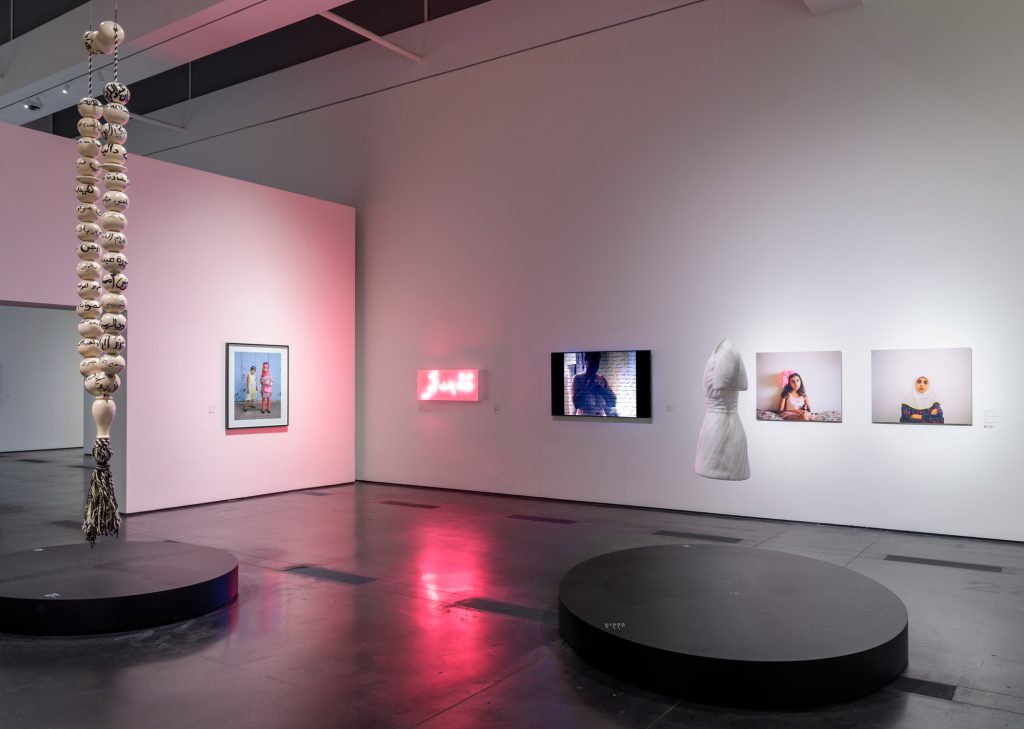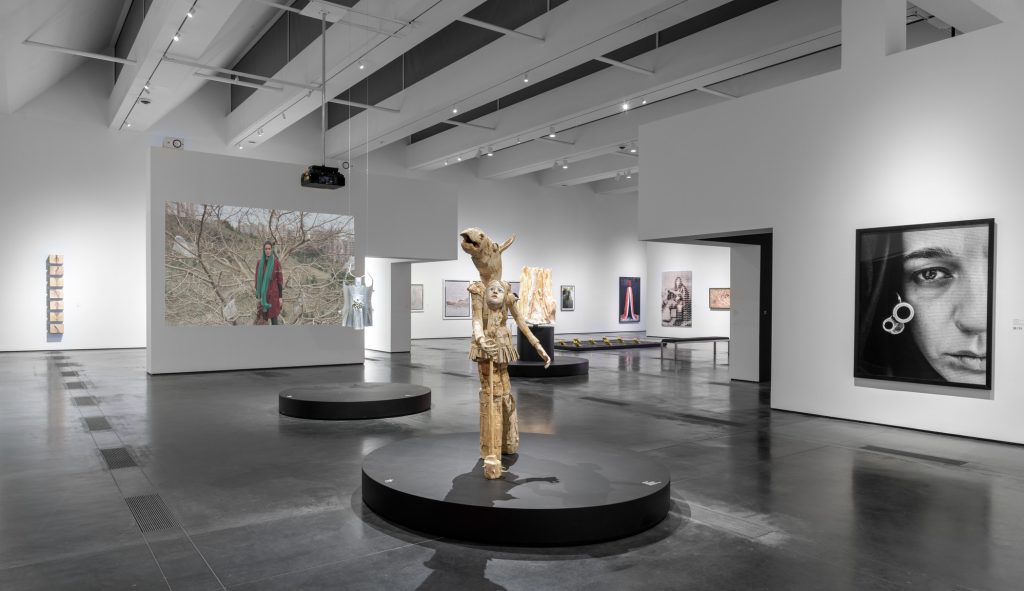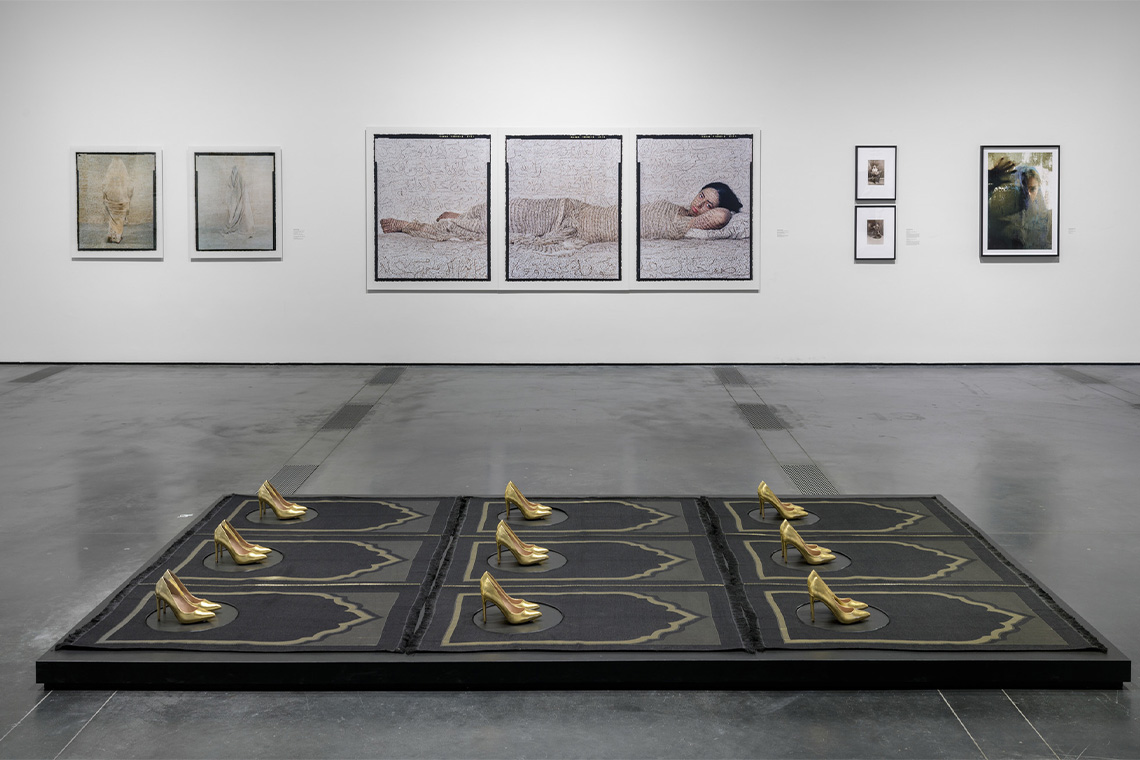The Los Angeles County Museum of Art show Women Defining Women in Contemporary Art of the Middle East and Beyond aims to unpick what it means to be a woman in the multi-layered complexity of an increasingly unfettered region.
“One of the phrases I heard the most when I was a kid was ‘What will people say?’”, recalled Yasmine Nasser Diaz, a Los Angeles-based artist, in a conversation about her upbringing as a girl in a conservative Yemeni family in the USA. “It feels like we are all held hostage by what other people might think of us.” The clip was part of the audio library accompanying the exhibition Women Defining Women in Contemporary Art of the Middle East and Beyond at the Los Angeles County Museum of Art (LACMA), curated by its Middle Eastern Art curator, Linda Komaroff. The extensive show, presented across the institution’s Resnick Pavilion, features 75 works by 42 artists and spans video, painting, sculpture and a vast amount of photography, with most of the items drawn from LACMA’s own collection. Echoing Diaz’s childhood memory, the exhibition aims to give agency and self-definition to multiple generations of female artistic voices born or living in Islamic societies.
In true LA fashion, visitors are greeted by the face of an actress. Lebanese-American photographer Rania Matar portrays Iman Vellani, immediately known to some as “Ms. Marvel” from the eponymous 2022 Marvel TV series. Iman, Griffith Park (2022) features the young celebrity in a blue mini-dress sitting on a stone bench and staring directly back at viewers, with the photographs and paraphernalia of her Pakistani grandparents spread before her. Neighbouring images by Iranian artists emulate Matar’s unapologetic sentiment of a new female generation. Newsha Tavakolian’s Untitled (2011) pictures a woman in traditional black clothes, a headscarf, and bright red boxing gloves on an empty four-lane highway, while Shirin Aliabadi’s leading lady Miss Hybrid 3 (2008) dons a blonde wig and a nose bandage, blowing a pink gum bubble at the camera – uncompromising and combative portraits at a time of ongoing fights by women for freedom.

Close by, sculptural works introduce musings on feminine armament in the face of patriarchal force. Next to Yasmin Sinai’s life-size cardboard work The Act of Gurdafarid, the Female Warrior (2015), a figure with a horse head inspired by the fighter Gordafarid in Persian poetry, Naiza Khan’s steel vest Armour lingerie V (2007) and Deconstruction (Venus) (2021) by Turkish mixed-media artist Azade Köker play with female-read materials, personal and political bodies, and layers of learned and obscured brutality against women. Whereas Khan’s bedside battle armour sits at the intersection of seduction and violence, Köker’s circular sculpture of white headless gowns and dangling, bandaged limbs hints at untold stories of domestic abuse and femicides, the incidence of which in the artist’s home country having spiked in recent years.
With political stances abounding, intergenerational dialogues of female practices also turn to more subtle textural takes on the female physique. Deservedly featured as the exhibition’s advertising image, Hayv Kahraman’s mesmerising painting Search (2016) depicts naked, black-haired female figures dancing and gesturing across a large, raw canvas. The fragmentation of their bodies and the material itself – some sections of the painting surface are cut and folded outward in a geometric pattern – relates to the Iraqi-Kurdish artist’s reflections on fractured femininity and fixed cultural boundaries: “I’m all for harnessing energy [of indignation] in order to unlearn and rethink cultural norms,” the artist elaborated in her audio narration. Sara Al Haddad’s adjacent knitted body sculpture self portrait (2011) and Huda Lutfi’s House Bound (2006) – a pair of mannequin legs protruding from the wall, covered in portraits of famed Egyptian women – echo Kahraman’s exploration of women asserting themselves in physical spaces.
Meanwhile, works on paper consider questions of collective womanhood and representation. Iran-born painter Samira Abbassy’s two poetic works In My Hands, My Undoing (2013) and Intangible Threads (2011) portray women in charcoal, their figures enveloped in large hands patterned with flowers and their heads filled with other women’s faces and eyes – embodiments of shared female kinship. Elsewhere, Pakistani-American artist Shahzia Sikander’s Housed (1995), a shelter-like white gouache grid that resembles both a shuttlecock burka and a hut, mirrors conflicting feelings of erasure and stereotypes of Muslim women’s attitude, apparel and abode.

Middle Eastern fashion culture looms large in many of the exhibition’s works, such as the stiff cotton dress Dome (2010) by the sister-led fashion brand Dice Kayek, and Zoulikha Bouabdellah’s installation of high heels on prayer mats, Silence Noir (2016). However, only a handful of works manage to lift textile design out of the script of commodification. Gazelle Samizay’s surprisingly gritty video Upon My Daughter (2010) demonstrates the collective fashioning of wedding dresses and the symbolic capture of brides within them; and Shadi Ghadirian’s funky sepia photos from her 1998 Qajar series (inspired by the Iranian Qajar dynasty’s introduction of photography) juxtaposes female protagonists, clad in late 19th-century baggy pants and painted with the era style’s strong eyebrows, with contemporary gear like mountain bikes in a portrayal of gender roles wedged between modernity and tradition.
Toward the end, near works by artist heavyweights Shirin Neshat and Mona Hatoum, it is historic genealogies that demand ultimate attention. Iranian photo pioneer Hengameh Golestan’s small black-and-white images Untitled (both 1979), from her series Witness 1979, document women’s protests during the Iranian Revolution and sit right next to Manal AlDowayan’s 2005 works The Choice I and III which depict Saudi women staring back at viewers through car wheel and rearview mirror – a reference to the Saudi Arabian ban on women driving that was only lifted 13 years later.
Because of the exhibition’s ambitious breadth, the ways in which the myriad works on display are ‘defined’ ultimately remains vague. Whereas the artists forge strong narratives that dispel singular readings of non-Western forms of womanhood, the rigidity of the show’s context – for instance, the unexplored emphasis on women versus femininity – and an unguided, hazy geopolitical framing of ‘Middle East’ inthe title – leaves little space to delve into the multiplicity and fluidity that interlaces many of the practices. Yet however contentious in its conceptual body, Women Defining Women’s non-White energies generally resonate well with its locale. Displayed in a city that is powered by its diverse diasporic residents, the show offers space to absorb the reverberations of generations of female creative labour to LACMA’s more mainstream, recreational public.
Women Defining Women in Contemporary Art of the Middle East and Beyond runs until 24 September 2023



